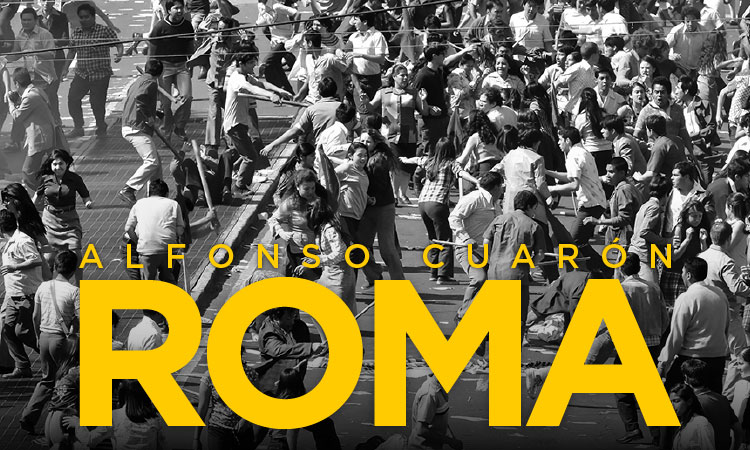Roma | Gravity Director Brings Spectacle to Autobiographical Drama
Roma is another visual wonder from Alfonso Cuaron. While it may lack the bombastic sci-fi of Children of Men or Gravity and the literal magic of his Harry Potter film, its quieter, almost neo-realistic depiction of a family in crisis still manages to be a joy to the senses.
Shot in black and white and set in early 70s Mexico City, Cleo (Yalitza Aparicio) is a maid for an upper class family with four children. While the matriarch Sofia (Marina de Tavira) attempts to keep home life harmonious, it soon becomes clear her doctor husband Antonio (Fernando Grediaga) has another lover and begins spending less time with his wife and kids. As Cleo tries supporting Sofia, she discovers she is pregnant and the father Fermin (Jorge Antonio Guerrero) wants nothing to do with the child.
Roma starts slow, taking time to establish its characters and their relation to each other. Scenes play out in long takes, where we merely observe the central players as they go about their lives. However, the viewer is never bored. This is because Cuaron (who on top of directing, wrote and shot Roma) packs the frame with so much detail. In a scene where the family go to a fair, one can see a man being shot out of a canon in the far right background. In another moment, a character sings directly to the viewer while people behind him in the frame battle a forest fire.
The entire film is filled with moments like this. Shot in a deep focus that recalls cinematographer Gregg Toland’s work on Citizen Kane, it feels like if Cuaron just shifted his camera away from Cleo or Sofia slightly, the audience would fall into a different movie. The same goes for the aural mixing in Roma. As Cleo walks down a busy Mexico City street, in surround sound you hear the most authentic cacophony of noise. Buskers, busy traffic, car radios, people shouting, a parade march in the distance – the sound is so well mixed that one can actually triangulate in their mind how far the noise is away from Cleo without ever seeing the origin.
The measured pace of Roma’s opening section – where Cuaron just immerses viewers in the world of the film – makes the sudden, shocking moments of the drama hit all the more harder. Without spoiling, there are unexpected bursts of violence. One particularly distressing sequence is all the more disturbing for how realistic the event is depicted and how slowly you have come to care for the person suffering through it. Meanwhile, not long after it – just when you thought it was safe – the movie unleashes a swimming sequence so nerve-inducing, it recalls the infamous beach scene in Under the Skin. All the while Cuaron shoots these moments with as much formal filmmaking panache – long takes, set in a back drop of stunning wide vistas – as any of his Hollywood blockbusters.
There is also the autobiographical element to Roma. The drama is shot where the writer-director lived as a boy and functions as an ode to the females who raised him. The love practically radiates off the screen as the film is at its heart a story about women being let down by weak men. At her lowest, Sofia says: “Women are always alone in the end.” However, Cleo and Sofia are not depicted as downtrodden victims. Part of the joy of Roma is seeing these two people from radically different backgrounds come together to raise a de facto family. Cuaron even suggests he wouldn’t be a filmmaker if it wasn’t for his mother and nanny. At one point, we see the two take the children to the cinema to see a film with spacemen, resembling a rinky dink version of Gravity.

All the said, there is a nagging feeling that Cuaron may have slightly underserved the male figures in the film turning them into caricatures. Fermin brags about how strong he is on account of his martial arts training. Yet, when Cleo tells him in public she is pregnant, he pretends to go to bathroom and abandons her. Meanwhile, Sofia’s husband comes across as solely caring about himself, not just in the home but at work too. When Cleo is rushed into surgery, he invents excuses not to accompany her into her operation.
While it is perfectly acceptable to depict men as cowardly and selfish, the depiction is so black and white in a film striving hard for authenticity (another secondary male figure at one point forgets to put on trousers before entering outdoors in another oddly broad scene). This is a slight problem as one never understands why Cleo and Sofia were ever attracted to these people.
Meanwhile, one doesn’t want to criticise Netflix too much for their distribution of Roma. Due to them, more will have a chance to see this than the standard art house release. That said, it is a shame the film is only going to play in one theatre in Dublin. This critic saw the drama on a massive multiplex screen. Having done so, there is a slight worry that perhaps Roma won’t bewitch audiences as strongly on Netflix as the techniques Cuaron uses to immerse viewers into the authentic neo-realist world – filling the frame to the brim with detail, unbelievable sound mixing – will be lost streaming it on a smaller screen.
While I’d urge people to see Roma any way they can, one will get more out of the experience the bigger the screen. Dark, long, scary and unexpected but also beautiful, bright, funny and heart-warming, Cuaron’s latest captures the strange wonders of life.

